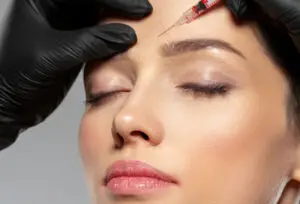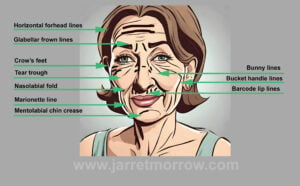How you sleep can play an important role in the development of wrinkles. One of the more common discussions that I have in my cosmetic practice is about the prevention and treatment of sleep wrinkles. While Botox itself or other neuromodulators may seem like the magical wrinkle eraser, it primarily works on dynamic wrinkles that are formed from muscle contraction during facial expression. This means that it likely will not work for the treatment of wrinkles that form mechanical compression of skin while you sleep. Restylane® Skinboosters and other dermal fillers may offer some relief though. While I usually discourage the idea of chasing wrinkles and encouraged other means to alleviate facial aging (restoring volume loss in facial fat compartments), there are certainly occasions where it is necessary to reduce the appearance of certain wrinkles to restore a youthful appearance in my clients.
Aging is a process that we cannot stop or in many cases completely control. However, as one of my patients was kind enough to bring to my attention, as bad as aging is, it’s better than the alternative. As the body ages, it goes through a series of changes. One of the most apparent changes in its appearance. Body hair becomes lighter, and wrinkles begin to appear on the skin’s smooth surface. While a few wrinkles tend to make an individual appear distinguished, many seek to keep the extent of their wrinkles in check.
Researchers at the University of Nevada (Anson et al, 2016) reviewed the published literature pertaining to sleep wrinkles. Let’s have a look at some of the salient points from their review article.
How do Wrinkles Form?
Regular facial expressions are responsible for the majority of wrinkle patterns appearing on the face. However, not all facial wrinkles occur as a result of voluntary muscle contractions. Sleep wrinkles differ from traditional facial animated wrinkles as they form in response to the face pressing up against a sleeping surface (aka your pillow). In younger people, the wrinkles disappear once the force is removed but aging skin does not possess the characteristics to bounce back in the same regard.
There are many differences between sleep wrinkles and expression or dynamic wrinkles. Sleep wrinkles happen as a result of an external force while expression wrinkles occur because of muscle contractions. The two different types of wrinkles appear in different areas of the face and are directly perpendicular to one another. Due to these factors, it is only wise to consider how wrinkles are classified. Sleep wrinkles which are caused by the face being distorted while the body is at rest cause fine lines and contribute to overall facial aging. Sleep wrinkles are formed by mechanical, compressive, or shear forces primarily when you sleep on your side or stomach. In short, when you sleep supine or on your back, the only effect on your face in terms of aging is gravity.
The Wrinkle Classification Scale
Wrinkle classification scales are used to grade wrinkles for clinical comparisons. Different classification scales have been proposed that would classify wrinkles into categories based on how they develop and their histology. Sleep wrinkles are not recognized in any wrinkle classification systems that presently exist.
One of the most renowned wrinkle classification systems is Pierards four-category system. Pierards system is based on suggested causes of the faulted lines and the differences in the tissues. According to Pierard, there are four different types of wrinkles. The four types of wrinkles are atrophic, elastotic, expressional, and gravitational.
- Atrophic wrinkles develop in both skin that is exposed and not exposed to the sun. They disappear whenever the skin is under tension and are due to muscle weakening and breakdown.
- Elastotic wrinkles develop when the skin is exposed to the sun. They start off progressively small and disappear when the skin is younger, but as the skin ages, they start to become permanent.
- Expressional wrinkles develop as a result of facial contractions. Over time as the facial muscles weaken, the wrinkles become permanent.
- Gravitational wrinkles are a result of the gravitational pull on the body.
According to Pierard, gravitational wrinkles occur because of the gravitational pull of the earth. Tension, compression, and forces that are applied to our faces while we sleep may have a bigger impact on wrinkles than gravity by itself.
The Study of Aging Skin
There are many extrinsic factors that affect the skin. Smoking, sun exposure, hormones, and other environmental factors play a role in the appearance and histology of the skin. As the skin ages, one of the most consistent features amongst all is a stiffening effect on its dermal layer. Other changes also occur which include, decreased elasticity, decreased collagen, and decreased water retention. The decrease in water content is what contributes to the epidermal layer of the skin stiffening.
The thickness of the skin is something that also reportedly changes with age. With sun exposure the skin becomes thicker in some areas (not around the eyes) but decreases in overall thickness as time persists. One of the most consistent findings of skin aging is an increase in stiffness of the epidermis and dermis.
How Aging Skin Works
As the skin starts to age, its response to applied force changes. Think of your skin as an elastic piece of tissue that distorts itself in response to tension, compression, and miscellaneous forces. Whenever a force is applied, this can result in strain and deformation. The skin’s ability to bounce back from these applied forces changes drastically with age. The elasticity of the skin and ability to recoil and stretch back when under pressure, diminishes with age and repetition.
Why Do Wrinkles Form?
When young skin is compressed, many thin wrinkles occur, and gradually diminish in a few minutes. Skin that is not as elastic will develop wrinkles in a smaller more localized area. Localized compression to aged skin for a prolonged period of time, will take the skin longer to bounce back from—if it does at all. A decrease in skin elasticity and extensibility is closely associated with wrinkle formation as the body ages.
Wrinkles occur on the body when the balance between the three skin layers is disturbed. The dermal and epidermal layers stiffen at different points, which causes the other layers of the skin to buckle under pressure. Repetitive damage to the skin’s surface caused by external and internal forces will ultimately result in permanent wrinkles. Wrinkles caused by compression will run parallel to the movement of the face.

What Are Sleep Wrinkles?
Sleep wrinkles are not a new concept. A clinical study performed by Fulton (Fulton et al 1999) and other researchers concluded that sleep wrinkles develop as a result of sleep position and site. The team identified the common sites that these types of wrinkles occur in. Polisak (et al 2012), attempted to simulate how sleep wrinkles occur by using a transparent pillow as a prop. In general, sleep wrinkles are typically vertical lines parallel to your face.
While sleeping on your stomach or your side, your facial tissues are subjected to compression and other mechanical forces. Skin is stretched in various directions whenever sleep positions are changed. The significance of these forces increases when we consider the time that is spent in each sleep position. The onset of sleep wrinkles matches the onset of expressional wrinkles. Over time, as pressure continues to be added to the area, and the skin loses its collagen and elasticity, the face lacks its ability to bounce back like it once did in youth.
How to Stop Sleep Wrinkles?
Treatment options for sleep wrinkles are limited in comparison to expressional wrinkles. Tightening procedures, such as facelifts can temporarily decrease the amount of skin that buckles under pressure and alter the attachment sites. Dermal fillers can help to temporarily remove wrinkles of various types. Neurotoxins (Botox, Dysport, and Xeomin) can help improve the appearance of fine lines and wrinkles caused by mechanical stress but won’t work for true sleep wrinkles.
To decrease the risk of developing sleep wrinkles, sleeping your back will help but may aggravate other health conditions. Specialty pillows may be used to minimize facial distortion and compression during sleep. I generally recommend that my clients use down-filled pillows to reduce the effects of sleep wrinkles. For healthy aging, it is important to eliminate external factors from your life that encourage aging, such as smoking, and optimize your skincare to help slow down the aging process.
Summary
- Sleep on your back (if you can and it does not impact other health conditions)
- Avoid the use of memory foam pillows. Consider down-filled (if you don’t have any allergies) or buckwheat
- Avoid smoking and excessive sun exposure which will both contribute to a worsening appearance of the face.
- Use a moisturizer and sunscreen daily.
- Maintain a healthy body weight. Sleep wrinkles seem to more adversely affect those who are overweight or obese.
To learn more about treatment options in Victoria, click here to contact me.
References:
- Anson G, Kane MA, Lambros V. Sleep Wrinkles: Facial Aging and Facial Distortion During Sleep. Aesthet Surg J. 2016 Sep;36(8):931-40. doi: 10.1093/asj/sjw074. Epub 2016 Jun 21.
- Fulton JE, Gaminichi F. Sleep lines. Dermatol Surg. 1999;25:59-62.
- Poljsak B, Godic A, Lampe T, Dahmane R. The influence of sleeping on the formation of facial wrinkles. J Cosmet Laser Ther. 2012;14:133-138.






